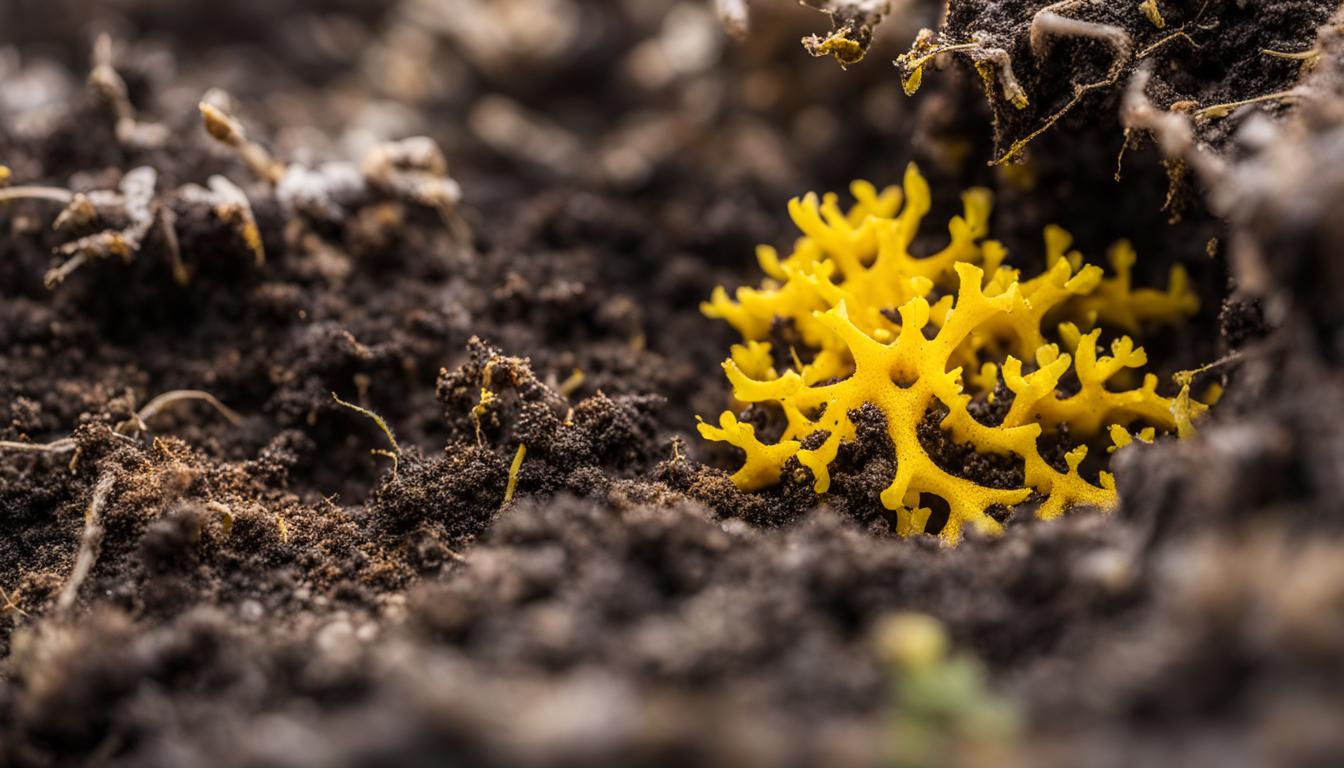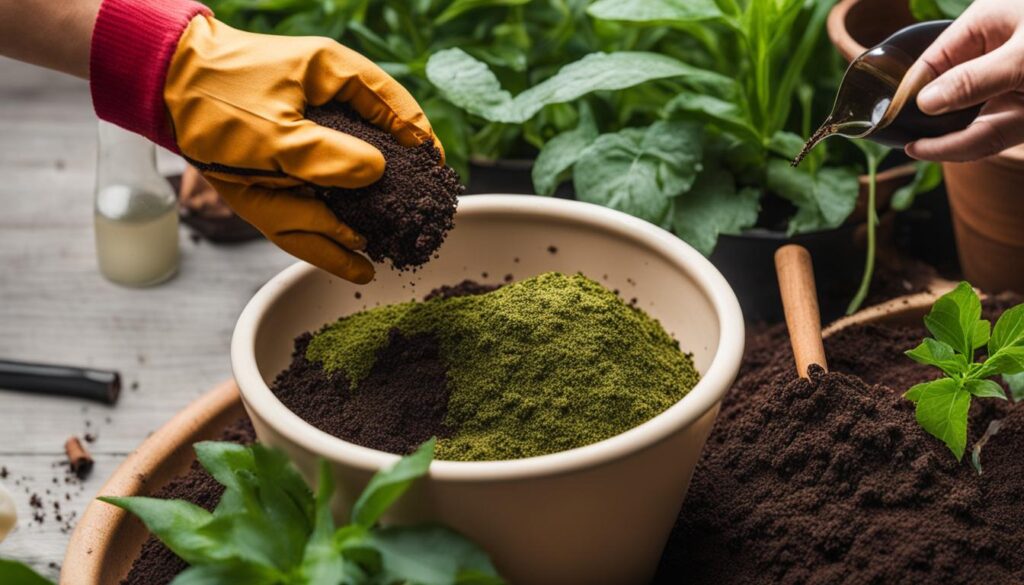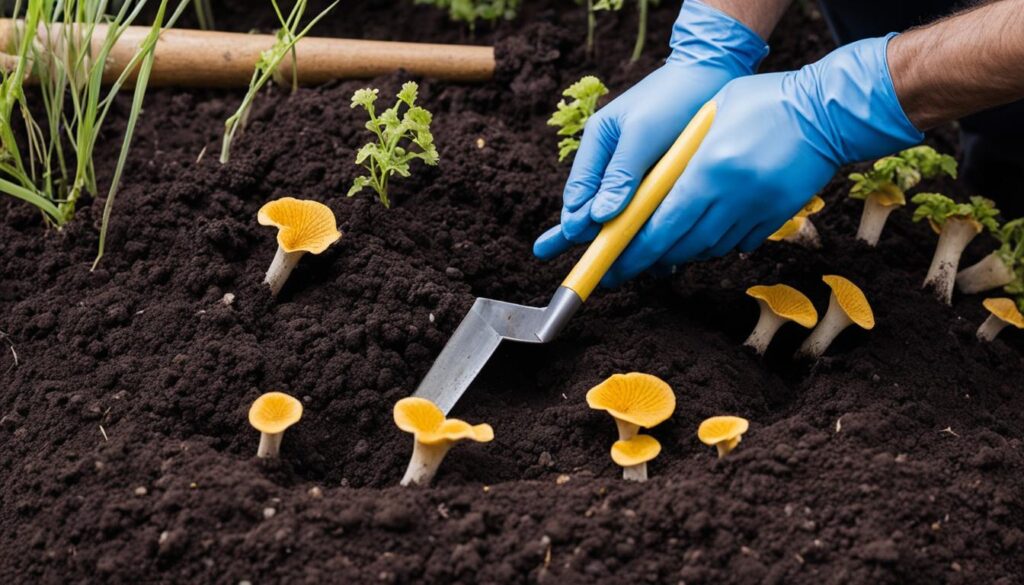
Yellow Fungus in Soil: Causes and Treatment
If you are a plant enthusiast or gardener, you may have encountered the issue of yellow fungus in soil. This fungal infection can have harmful effects on plants, leading to stunted growth, wilting, or even death.
It’s essential to understand the causes of yellow fungus in soil, the different types of fungus that can impact your garden’s health, and how to prevent and treat the infection effectively. In this article, we will explore yellow fungus in soil, its effects on plants, and practical solutions to manage and prevent its occurrence.
Key Takeaways:
- Yellow fungus in soil can cause significant harm to plants, leading to stunted growth, wilting, or death.
- Identifying the causes of yellow fungus and its different types is crucial for effective prevention and treatment.
- Natural remedies and managing soil conditions can help prevent and manage yellow fungus in soil.
- Professional assistance is available for those who require expert advice and reliable services for yellow fungus removal.
- Implementing long-term solutions such as maintaining healthy soil conditions can prevent future outbreaks of yellow fungus in soil.
Identifying Yellow Fungus in Soil
Yellow fungus can rapidly spread through soil and harm your plants. It is important to identify it early to prevent further damage. Symptoms of yellow fungus in plants include:
- Yellowing leaves: Leaves turn yellow and may drop prematurely, leaving bare branches.
- Wilting: Leaves and stems become weak and droopy.
- Stunted growth: Yellow fungus can cause the overall growth of plants to slow down.
- Discolored roots: The roots may appear brown or black and may have a foul odor.
The appearance of these symptoms in your plants is an indication of a yellow fungus infestation. Common causes of yellow fungus in soil include overwatering, poor drainage, and contaminated soil. Ensure your plants are adequately watered, but do not overwater them, as this can create ideal conditions for fungal growth.
Preventing yellow fungus in soil
Preventing yellow fungus in soil requires careful attention to soil conditions and plant health. Ensure that the soil is well-draining and not too compacted. Use organic mulch to improve soil structure and protect against dryness. Avoid overwatering and overcrowding plants, both of which create conditions favorable to fungal growth.
Preventing Yellow Fungus in Soil
Preventing yellow fungus in soil is crucial for maintaining healthy plant growth. Here are some natural remedies and prevention strategies:
- Maintain proper drainage: Poor drainage contributes to the accumulation of moisture in soil, creating favorable conditions for fungus growth. Ensure proper drainage by incorporating organic matter and using raised beds if necessary.
- Practice crop rotation: Crop rotation is an effective strategy for preventing the buildup of fungal spores in soil. Rotate crops regularly to minimize the risk of yellow fungus infestations.
- Use organic fungicides: Organic fungicides such as neem oil and garlic extract can help prevent fungal infections, while minimizing the use of harmful chemicals in the garden.
- Improve soil quality: Healthy soil contains a diverse and active community of microorganisms that can help resist fungal infections. Improve soil quality by adding compost, using cover crops, and avoiding over-fertilization.
- Avoid overcrowding: Crowded and poorly spaced plants can lead to increased humidity and reduced air circulation, providing excellent growing conditions for fungal spores.
Implementing these natural prevention strategies can help reduce the risk of yellow fungus in soil and ensure healthy plant growth.

Types of Yellow Fungus
Yellow fungus can manifest in various forms, each with unique characteristics and symptoms. It’s essential to identify the specific type affecting your plants to effectively manage the issue. Some common types of yellow fungus include:
| Fungal Name | Common Symptoms in Plants |
|---|---|
| Aspergillus | Yellowish growth on the soil surface; stunted growth and yellowing of leaves; decreased fruit and flower production. |
| Fusarium | Wilting of plants, yellowing of foliage and veins, stunted growth or complete plant death. |
| Phytophthora | Wilting/downsizing of plants, sunken discoloration on trunks/stems, yellowing of foliage and veins, decayed roots. |
Although these are the most commonly found yellow fungal types, there are several others, including Penicillium, Rhizoctonia, Sclerotinia, and more. The symptoms of each are similar, but subtle differences can make all the difference in effectively treating the problem.
It’s recommended to work with a professional to identify the specific fungal type in your garden and get a proper diagnosis.
Yellow Fungus Symptoms in Plants
As previously mentioned, yellow fungus infestations can produce a variety of symptoms in plants. The most common symptoms of yellow fungus in plants are:
- Discoloration of leaves
- Stunted growth
- Yellowing of leaves or veins
- Wilting
- Decreased fruit/flower production
- Decayed roots or trunks
If you notice any of these symptoms, it’s essential to take immediate action to prevent further damage and spread of the fungus.
Next, we will review the effects of yellow fungus on plants and ways to prevent yellow fungus in soil to ensure healthy plant growth.
Effects of Yellow Fungus on Plants
Yellow fungus can have severe and detrimental effects on plants. The fungus attacks the roots and stems of plants, affecting their ability to absorb water and nutrients. This can lead to stunted growth, yellowing or browning of leaves, and eventual wilting and death of the plant.
One of the tell-tale yellow fungus symptoms in plants is the appearance of yellow spots on leaves. Over time, these spots can enlarge, causing the leaves to turn yellow and eventually fall off. The presence of white, web-like growth on the surface of the soil or plant is also a common indicator of yellow fungus infestation.
It is essential to identify yellow fungus symptoms in plants as early as possible to prevent its spread and minimize the damage it can cause to your garden’s health. If you notice any yellow fungus symptoms in your plants, take action promptly to address the issue.
Regular inspection, maintenance, and care can help prevent yellow fungus in soil and protect the health of your plants. By promoting moist and well-drained soil, providing adequate sunlight, and avoiding overcrowding of plants, you can help create a healthy and thriving garden environment.
Treating Yellow Fungus in Soil
Yellow fungus in soil can adversely affect the health and growth of your plants, but there are effective treatment options to eliminate it. Here are methods to restore soil health and promote the recovery of affected plants.
- Isolate affected plants: If you notice symptoms of yellow fungus in your plants, remove them from the garden and dispose of them to prevent further contamination.
- Replace infected soil: Yellow fungus in soil can persist even after removing the infected plants. Replacing the contaminated soil will disrupt the fungus’s growth cycle and minimize the risk of a new outbreak.
- Use fungicides: Fungicides are chemical compounds that can eliminate yellow fungus and prevent it from reappearing. You can use a copper fungicide or a sulfur-based fungicide, depending on the severity of the infection. Ensure you follow instructions carefully, and wear personal protective equipment when applying the fungicide.
- Improve soil health: Yellow fungus thrives in damp, poorly drained soil. Ensure your garden has good drainage and air circulation to prevent fungal growth. Also, using compost and other organic matter can help improve soil health and prevent fungal infections.
“Effective treatment options for yellow fungus in soil include isolating affected plants, replacing contaminated soil, using fungicides, and improving soil health.”
Expert Tip:
For severe or recurring yellow fungus issues, consider reaching out to a professional mold remediation company like Fix Mold Miami. Their experts can assess your soil and plants for signs of contamination and provide reliable solutions for yellow fungus removal and prevention.
Professional Assistance for Yellow Fungus Issues
If you’re facing a yellow fungus infestation in your garden, seeking professional assistance is crucial to prevent long-term damage. We highly recommend Fix Mold Miami, a leading mold assessment and remediation service provider in Miami, Florida.
The expert team at Fix Mold Miami specializes in yellow fungus removal and prevention, offering a wide range of reliable services to ensure the safety and health of your garden. They use advanced equipment and techniques to assess the extent of the infestation and create effective treatment plans accordingly.
To reach out to Fix Mold Miami, give them a call at 305-465-6653 for reliable and expert advice. Their team of seasoned professionals will provide you with the guidance you need and help you prevent yellow fungus from wreaking havoc on your garden.

Implementing Long-Term Solutions
Preventing yellow fungus in soil requires a sustainable approach. While treating an infestation is essential, proper maintenance and care of soil can prevent future outbreaks. Here are some practical tips and strategies you can use to maintain healthy soil conditions and prevent yellow fungus infestations:
- Regularly monitor plant health: Check your plants for any signs of yellow fungus symptoms such as yellow leaves, wilting, or stunted growth. Early detection can help prevent the spread of fungus to healthy plants.
- Maintain proper drainage: Ensure your plants are not over-watered, as excessive moisture in soil can promote fungal growth. Use well-draining soil and avoid placing plants in areas with poor drainage.
- Practice proper sanitation: Regularly remove plant debris and any dead or diseased plant material to prevent fungal growth. Additionally, sterilize garden tools before use to prevent the spread of fungus.
- Use natural remedies: Organic solutions like neem oil and garlic can help prevent yellow fungus in soil. These natural fungicides can be sprayed on plants to combat fungal growth while preserving soil health.
- Rotate crops: Avoid planting the same crop in the same spot every year, as this can deplete soil nutrients and promote fungal growth. Crop rotation can help maintain soil health and prevent yellow fungus infestations.
By implementing these long-term solutions, you can prevent yellow fungus infestations and maintain the health and vitality of your plants.
Conclusion
In summary, yellow fungus in soil can be a major concern for plant enthusiasts. It can weaken plants, lead to stunted growth, and even cause death. However, by understanding the causes, symptoms, and treatment options, you can effectively manage and prevent yellow fungus infestations. Remember to implement long-term solutions, such as maintaining healthy soil conditions and using natural remedies, to prevent future outbreaks.
If you require professional assistance with yellow fungus removal and prevention, we highly recommend Fix Mold Miami, who specialize in mold assessments, prevention, and remediation in Miami, Florida. By contacting FixMold at 305-465-6653, you can receive expert advice and reliable services to ensure the safety and health of your plants.
Thank you for taking the time to learn about yellow fungus in soil. We hope this article has been informative and helpful to you in managing and preventing any potential fungal issues in your garden.
FAQ
What causes yellow fungus in soil?
Yellow fungus in soil is typically caused by a combination of factors, including poor drainage, overwatering, high humidity, and lack of sunlight. These conditions create an ideal environment for fungal growth.
How does yellow fungus affect plants?
Yellow fungus can have detrimental effects on plants. It can weaken their immune systems, inhibit photosynthesis, and hinder nutrient absorption. This can lead to stunted growth, yellowing or browning of leaves, wilting, and ultimately, plant death if left untreated.
What are the symptoms of yellow fungus in plants?
Symptoms of yellow fungus in plants include yellow or brown spots on leaves, wilting or drooping foliage, stunted growth, and an overall unhealthy appearance. Additionally, you may notice a yellowish powdery substance on affected plant parts.
How can I identify yellow fungus in soil?
To identify yellow fungus in soil, look for yellow or orange discoloration on the surface or around plant roots. You may also observe a foul smell and a web-like growth on the soil’s surface. Additionally, yellow fungus-infected plants often exhibit symptoms such as yellowing leaves and poor overall health.
What are the common causes of yellow fungus in soil?
The common causes of yellow fungus in soil include excessive moisture, poor air circulation, overwatering, compacted soil, nutrient deficiency, and presence of decaying organic matter. These conditions create an ideal breeding ground for yellow fungus.
How can I prevent yellow fungus in soil?
To prevent yellow fungus in soil, ensure good drainage by using well-draining soil and avoiding overwatering. Provide adequate sunlight and airflow to maintain a healthy environment. Regularly inspect and remove any decaying plant material, and practice crop rotation to prevent the build-up of fungal spores.
How do I treat yellow fungus in soil?
To treat yellow fungus in soil, you can remove the infected plants and dispose of them properly. Improve soil drainage by adding organic matter or amending the soil with perlite or sand. Applying a fungicide labeled for yellow fungus can also help control the spread. Consult with a garden center or professional for appropriate fungicide recommendations.
Are there any natural remedies for yellow fungus in soil?
Yes, there are natural remedies for yellow fungus in soil. These include using neem oil, baking soda, or a mixture of water and hydrogen peroxide as a foliar spray. Additionally, improving soil conditions through organic amendments like compost and practicing good plant care can also aid in the prevention and treatment of yellow fungus.
Can professional assistance help with yellow fungus issues?
Yes, professional assistance can be valuable for yellow fungus removal and prevention. Companies like Fix Mold Miami specialize in mold assessments, prevention, and remediation, including yellow fungus. For expert advice and reliable services in Miami, Florida, you can contact Fix Mold at 305-465-6653.
How can I implement long-term solutions to prevent yellow fungus in soil?
Implementing long-term solutions involves maintaining proper soil drainage, promoting good air circulation, avoiding overwatering, and providing adequate sunlight. Regularly inspect and remove decaying plant material, practice crop rotation, and ensure proper plant nutrition for strong and healthy plants that are less susceptible to yellow fungus infestations.




